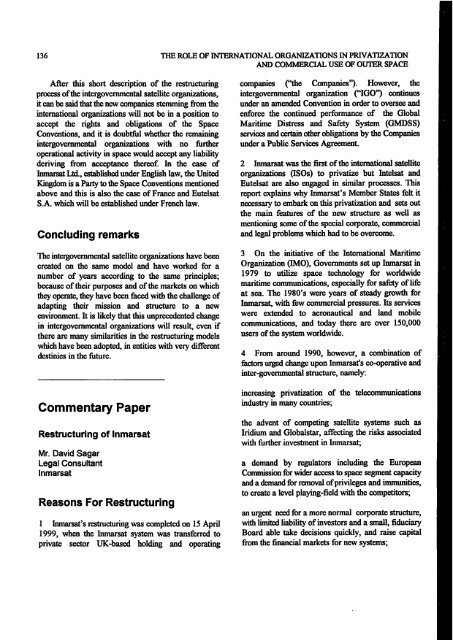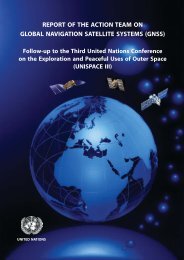Proceedings of the Workshop - United Nations Office for Outer ...
Proceedings of the Workshop - United Nations Office for Outer ...
Proceedings of the Workshop - United Nations Office for Outer ...
- No tags were found...
Create successful ePaper yourself
Turn your PDF publications into a flip-book with our unique Google optimized e-Paper software.
136 THE ROLE OF INTERNATIONAL ORGANIZATIONS IN PRIVATIZATIONAND COMMERCIAL USE OF OUTER SPACEAfter this short description <strong>of</strong> <strong>the</strong> restructuringprocess <strong>of</strong> <strong>the</strong> intergovernmental satellite organizations,it can be said that <strong>the</strong> new companies stemming from <strong>the</strong>international organizations will not be in a position toaccept <strong>the</strong> rights and obligations <strong>of</strong> <strong>the</strong> SpaceConventions, and it is doubtful whe<strong>the</strong>r <strong>the</strong> remainingintergovernmental organizations with no fur<strong>the</strong>roperational activity in space would accept any liabilityderiving from acceptance <strong>the</strong>re<strong>of</strong>. In <strong>the</strong> case <strong>of</strong>Inmarsat Ltd., established under English law, <strong>the</strong> <strong>United</strong>Kingdom is a Party to <strong>the</strong> Space Conventions mentionedabove and this is also <strong>the</strong> case <strong>of</strong> France and EutelsatS.A. which will be established under French law.Concluding remarksThe intergovernmental satellite organizations have beencreated on <strong>the</strong> same model and have worked <strong>for</strong> anumber <strong>of</strong> years according to <strong>the</strong> same principles;because <strong>of</strong> <strong>the</strong>ir purposes and <strong>of</strong> <strong>the</strong> markets on which<strong>the</strong>y operate, <strong>the</strong>y have been faced with <strong>the</strong> challenge <strong>of</strong>adapting <strong>the</strong>ir mission and structure to a newenvironment. It is likely that this unprecedented changein intergovernmental organizations will result, even if<strong>the</strong>re are many similarities in <strong>the</strong> restructuring modelswhich have been adopted, in entities with very differentdestinies in <strong>the</strong> future.Commentary PaperRestructuring <strong>of</strong> InmarsatMr. David SagarLegal ConsultantInmarsatReasons For Restructuring1 Inmarsat’s restructuring was completed on 15 April1999, when <strong>the</strong> Inmarsat system was transferred toprivate sector UK-based holding and operatingcompanies (“<strong>the</strong> Companies”). However, <strong>the</strong>intergovernmental organization (“IGO”) continuesunder an amended Convention in order to oversee anden<strong>for</strong>ce <strong>the</strong> continued per<strong>for</strong>mance <strong>of</strong> <strong>the</strong> GlobalMaritime Distress and Safety System (GMDSS)services and certain o<strong>the</strong>r obligations by <strong>the</strong> Companiesunder a Public Services Agreement.2 Inmarsat was <strong>the</strong> first <strong>of</strong> <strong>the</strong> international satelliteorganizations (ISOs) to privatize but Intelsat andEutelsat are also engaged in similar processes. Thisreport explains why Inmarsat’s Member States felt itnecessary to embark on this privatization and sets out<strong>the</strong> main features <strong>of</strong> <strong>the</strong> new structure as well asmentioning some <strong>of</strong> <strong>the</strong> special corporate, commercialand legal problems which had to be overcome.3 On <strong>the</strong> initiative <strong>of</strong> <strong>the</strong> International MaritimeOrganization (IMO), Governments set up Inmarsat in1979 to utilize space technology <strong>for</strong> worldwidemaritime communications, especially <strong>for</strong> safety <strong>of</strong> lifeat sea. The 1980’s were years <strong>of</strong> steady growth <strong>for</strong>Inmarsat, with few commercial pressures. Its serviceswere extended to aeronautical and land mobilecommunications, and today <strong>the</strong>re are over 150,000users <strong>of</strong> <strong>the</strong> system worldwide.4 From around 1990, however, a combination <strong>of</strong>factors urged change upon Inmarsat's co-operative andinter-governmental structure, namely:increasing privatization <strong>of</strong> <strong>the</strong> telecommunicationsindustry in many countries;<strong>the</strong> advent <strong>of</strong> competing satellite systems such asIridium and Globalstar, affecting <strong>the</strong> risks associatedwith fur<strong>the</strong>r investment in Inmarsat;a demand by regulators including <strong>the</strong> EuropeanCommission <strong>for</strong> wider access to space segment capacityand a demand <strong>for</strong> removal <strong>of</strong> privileges and immunities,to create a level playing-field with <strong>the</strong> competitors;an urgent need <strong>for</strong> a more normal corporate structure,with limited liability <strong>of</strong> investors and a small, fiduciaryBoard able take decisions quickly, and raise capitalfrom <strong>the</strong> financial markets <strong>for</strong> new systems;
















